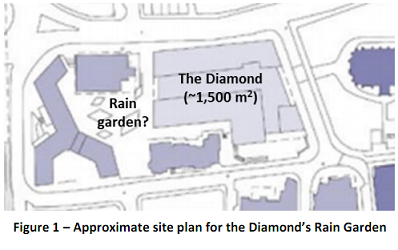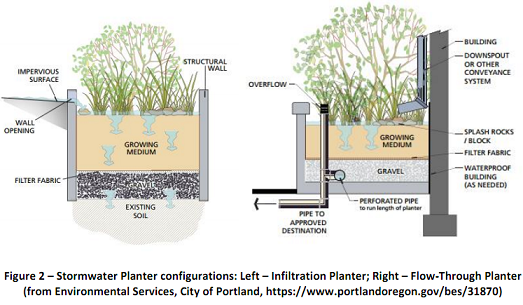Reference no: EM131421817
Stormwater Planter Hydrological Model
Introduction
The overall aim of this coursework is to construct a simple hydrological model (using MATLAB or Excel) that is able to predict both the volume and timing of runoff from a stormwater planter (or rain garden) in response to an arbitrary rainfall input (i.e. rainfall time-series or design storm). You will then use your model to suggest suitable design dimensions for a specific stormwater planter installation and comment on how effectively the planter performs. We will only consider hydrological performance here (i.e. ignoring considerations relating to water quality, amenity, biodiversity or broader Green Infrastructure).
Design Overview
The Diamond building occupies an area of approximately 1,500 m2. There is a large area of paved open space to the west of the building, between it and the Jessops West building. The University would like to explore the possibility of constructing a stormwater planter (or rain garden) within this space. Assume that all of the rainfall from the Diamond building's roof is currently directed to a combined sewer via an outlet on the western side of the building, which is accessible from above ground.

Process -
Step 1 - Literature Review - identify relevant previous research/guidance.
Step 2 - Develop a stormwater planter rainfall/runoff model, using either MATLAB or Excel.
Step 3 - Apply the model to suggest designs for the two specific design scenarios described below.
Step 4 - Discuss how sensitive the model output is to infiltration rate and evapotranspiration rate.
Step 5 - Comment on how effective the SuDS you have proposed are in managing stormwater on an annual basis, using the Sheffield 2007 rainfall record as input. For example, what fraction of the annual inflow would be lost to evapotranspiration or infiltration or passed back into the combined sewer?
Model Development -
Use Stovin et al. (2013; 2015) (focusing on retention and detention due to green roofs respectively) as a starting point, but then consider the following differences:
- Stormwater Planters/Rain Gardens may have a sealed base (with overflow back to the sewer) or infiltrate into the ground; you will need to model both options.
- Natural infiltration rates vary widely.
- Stormwater planters accept runoff from adjacent impermeable surfaces; green roofs typically only drain their own surface area.
- Stormwater planters often have deeper substrates compared with green roofs, and may support bigger plants. How will these differences impact on evapotranspiration rates and on overall retention?
- Stormwater planters may be designed to accommodate ponding.
- Your model will need to keep track of the moisture level within the planter.

Design Scenarios
You should generate two alternative stormwater planter designs - see Options A and B below. Use your model: i) to demonstrate that both designs meet the design storm requirements given in Table 1; and ii) to comment on the annual water balance. You have been provided with the 5-minute rainfall depths for Sheffield for the full year 2007 (on MOLE, Week 1 revision). Rainfall depths for different durations with return periods of 1, 10 and 100 years are provided in Table 1.
Table 1 - Design storm depths (mm) for Sheffield (FEH CD-ROM)
|
Return Period (years)
|
Event Duration (hours)
|
|
0.25
|
0.5
|
0.75
|
1
|
2
|
4
|
|
1
|
3.07
|
4.26
|
5.17
|
5.92
|
8.22
|
11.42
|
|
10
|
13.29
|
17.07
|
19.77
|
21.94
|
28.18
|
36.21
|
|
100
|
29.55
|
36.39
|
41.1
|
44.81
|
55.18
|
67.96
|
Option A - An Infiltration Planter (Figure 2, left)
This design assumes that soil conditions on the site are favourable for infiltration. Design a planter capable of infiltrating the critical duration 1 in 10 year design event. Temporary ponding of up to 100 mm depth is permitted.
Option B - A Flow-Through Planter (Figure 2, right)
This design assumes that infiltration at the site is not possible. Design a flow-through planter capable of dealing with the critical duration 1 in 10 year design event. Temporary ponding of up to 100 mm depth is permitted. The outflow from the drainage layer back to the sewer should be restricted to a suitable greenfield runoff rate. Overflow back to the sewer is permitted for events in excess of 1 in 10 years, once a ponding depth of 100 mm is exceeded.
In each case you need to provide a clear statement and/or engineering drawing of the planter design dimensions. You also need to include graphs showing how both the outflow(s) and the moisture depth within the planter vary during the design storm. All design assumptions (including the storm profile peakedness selected, time-step, initial moisture content, infiltration rates & evapotranspiration rates) should be stated and justified.
Further discussion of option A should consider the following:
a) How sensitive is the design to infiltration rate? - You should explore both 'typical' infiltration rates and also consider what values might be expected for this specific site.
b) How sensitive is the design to the evapotranspiration rate? What fraction of the annual inflow to the planter would be removed due to evapotranspiration?
c) Comment on how the design will respond to events larger than the critical design storm.
d) Any other aspects you feel are relevant.
Further discussion of Option B should consider the following:
a) How sensitive is the design to the green field runoff rate?
b) How sensitive is the design to the evapotranspiration rate? What fraction of the annual inflow to the planter would be removed due to evapotranspiration?
c) How effective is the design in attenuating runoff peaks, both for the design and routine storms?
d) Any other aspects you feel are relevant.
Assessment Criteria -
1. Literature Review. Undertake a focused review of relevant literature.
2. Model. Develop a one-dimensional hydrological model capable of predicting runoff from - and moisture levels within - a stormwater planter in response to an arbitrary (design or time-series) rainfall input.
3. Design. Apply the model to design two different types of stormwater planter to meet prescribed performance targets.
4. Exploration. Use the model to generate a deeper understanding of how stormwater planter performance is affected by key input variables.
5. Communication. Communicate findings in a clear and focused report.
Assignment Files - https://www.dropbox.com/s/6z9vhonc2j6biqr/Assignment%20Files.rar?dl=0